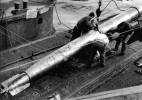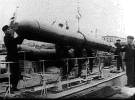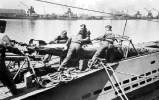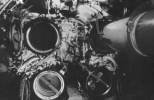

|
TV (G7es) Acoustic Homing Torpedo
 |
 |
 |
 |
As allied escorts gained mastery over their attackers, the Germans had an increasingly urgent need to develop an anti-escort weapon. Although research in acoustic homing torpedoes had already begun in 1934, but the technology was slow to mature. The acoustic torpedo was based on two hydrophones, placed side by side which directed the torpedo to home in on the target’s noise signature. Due to the problem of the torpedo’s self noise, the maximum speed that could be achieved was 25 knots. In addition, the sensor was only sensitive to targets moving at between 12 and 19 knots. If the escort ship moved at a significantly higher or lower speed, the torpedo would have difficulty tracking them. Out of necessity, the arming range was shortened to 250 meters. It was also not unknown for the acoustic torpedo to turn around and try to sink the U-boat that had launched it. Thus as soon as it was fired, the U-boat would have to dive deep as quickly as possible.
The first model T IV (G7es) Falke (Falcon) was introduced in early 1942. It had a contact pistol and a maximum range of 7,500 meters at 20 knots. The relatively slow speed and lack of a magnetic pistol made it in service for a brief period only when it was succeeded by the next generation.
The next generation was designated T Vb (G7es), Zaunkonig (Wren). The allies referred to them as “Gnat”. Based on the T III model, it had a combination of magnetic and contact pistol and a maximum range of 5,750 meters at 24.5 knots. However the Zaunkonig was prone to premature detonation, and since the launching U-boat had to dive deep; and unable to positively confirm the success, many times premature explosions were misconstrued as a hit – leading to somewhat exaggerated claims of its effectiveness. It was not until spring of 1944 that Donitz began to suspect the Zaunkonig was not as effective as he had hoped for.
The allies had a great deal of intelligence about the Zaunkonig – even before it had entered service. Thus as soon as they had confirmation that an acoustic torpedo was being used, they introduced the Foxer, an anti-acoustic torpedo device. This noise maker was towed behind warships to decoy the acoustic sensors of the torpedo. While designed to lure the acoustic torpedo away, it made such a loud noise that it broadcasted the convoy’s location for miles away, attracting U-boats which would have otherwise not have heard the convoy. In addition, it also interfered with the escort’s sensors and sonar, making it of dubious value in its role.
Realizing what was happening, the Germans introduced the second generation of acoustic torpedoes which were more accurately tuned to a ship’s propeller noise. The T XI (G7es) Zaunkonig II also had an improved range and sensitivity, enabling targets moving at 9 knots to be tracked. The Zaunkonig II could also be launched from up to depths of 50 meters (164 feet), compared to 15 meters (49 feet) for Zaunkonig I. As these later versions of acoustic torpedoes were deployed, the allies continued to improve the Foxer.
Range/Speed: 5,750m at 24.5kt
Warhead: 274kg



